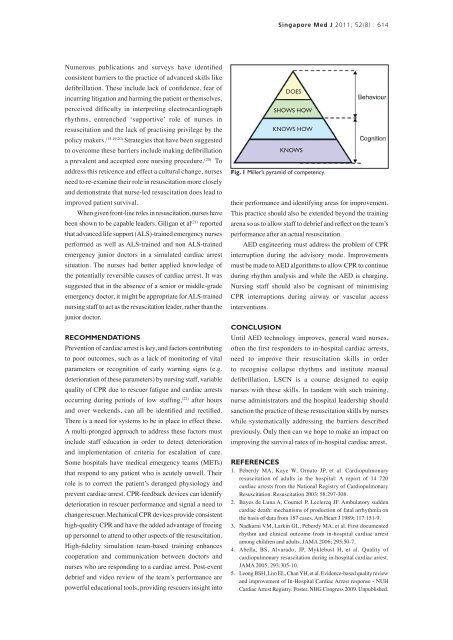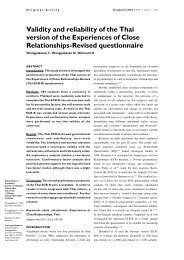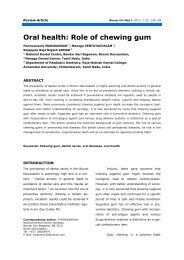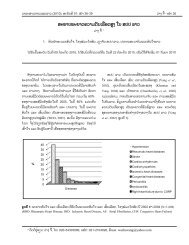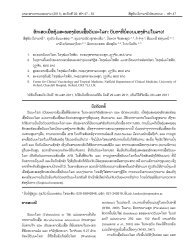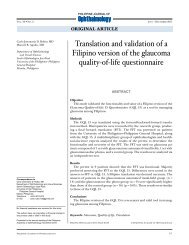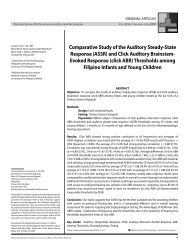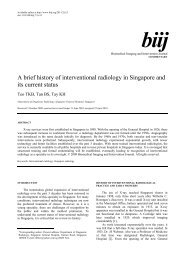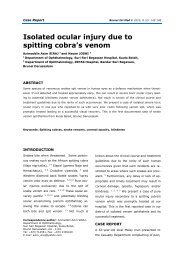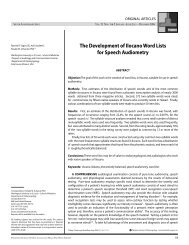PDF ( B) - APAMED Central
PDF ( B) - APAMED Central
PDF ( B) - APAMED Central
You also want an ePaper? Increase the reach of your titles
YUMPU automatically turns print PDFs into web optimized ePapers that Google loves.
Singapore Med J 2011; 52(8) : 614<br />
Numerous publications and surveys have identified<br />
consistent barriers to the practice of advanced skills like<br />
defibrillation. These include lack of confidence, fear of<br />
incurring litigation and harming the patient or themselves,<br />
perceived difficulty in interpreting electrocardiograph<br />
rhythms, entrenched ‘supportive’ role of nurses in<br />
resuscitation and the lack of practising privilege by the<br />
policy makers. (15,19,20) Strategies that have been suggested<br />
to overcome these barriers include making defibrillation<br />
a prevalent and accepted core nursing procedure. (20) To<br />
address this reticence and effect a cultural change, nurses<br />
need to re-examine their role in resuscitation more closely<br />
and demonstrate that nurse-led resuscitation does lead to<br />
improved patient survival.<br />
When given front-line roles in resuscitation, nurses have<br />
been shown to be capable leaders. Giligan et al (21) reported<br />
that advanced life support (ALS)-trained emergency nurses<br />
performed as well as ALS-trained and non ALS-trained<br />
emergency junior doctors in a simulated cardiac arrest<br />
situation. The nurses had better applied knowledge of<br />
the potentially reversible causes of cardiac arrest. It was<br />
suggested that in the absence of a senior or middle-grade<br />
emergency doctor, it might be appropriate for ALS-trained<br />
nursing staff to act as the resuscitation leader, rather than the<br />
junior doctor.<br />
RECOMMENDATIONS<br />
Prevention of cardiac arrest is key, and factors contributing<br />
to poor outcomes, such as a lack of monitoring of vital<br />
parameters or recognition of early warning signs (e.g.<br />
deterioration of these parameters) by nursing staff, variable<br />
quality of CPR due to rescuer fatigue and cardiac arrests<br />
occurring during periods of low staffing, (22) after hours<br />
and over weekends, can all be identified and rectified.<br />
There is a need for systems to be in place to effect these.<br />
A multi-pronged approach to address these factors must<br />
include staff education in order to detect deterioration<br />
and implementation of criteria for escalation of care.<br />
Some hospitals have medical emergency teams (METs)<br />
that respond to any patient who is acutely unwell. Their<br />
role is to correct the patient’s deranged physiology and<br />
prevent cardiac arrest. CPR-feedback devices can identify<br />
deterioration in rescuer performance and signal a need to<br />
change rescuer. Mechanical CPR devices provide consistent<br />
high-quality CPR and have the added advantage of freeing<br />
up personnel to attend to other aspects of the resuscitation.<br />
High-fidelity simulation team-based training enhances<br />
cooperation and communication between doctors and<br />
nurses who are responding to a cardiac arrest. Post-event<br />
debrief and video review of the team’s performance are<br />
powerful educational tools, providing rescuers insight into<br />
their performance and identifying areas for improvement.<br />
This practice should also be extended beyond the training<br />
arena so as to allow staff to debrief and reflect on the team’s<br />
performance after an actual resuscitation.<br />
AED engineering must address the problem of CPR<br />
interruption during the advisory mode. Improvements<br />
must be made to AED algorithms to allow CPR to continue<br />
during rhythm analysis and while the AED is charging.<br />
Nursing staff should also be cognisant of minimising<br />
CPR interruptions during airway or vascular access<br />
interventions.<br />
CONCLUSION<br />
DOES<br />
SHOWS HOW<br />
KNOWS HOW<br />
KNOWS<br />
Fig. 1 Miller’s pyramid of competency.<br />
Until AED technology improves, general ward nurses,<br />
often the first responders to in-hospital cardiac arrests,<br />
need to improve their resuscitation skills in order<br />
to recognise collapse rhythms and institute manual<br />
defibrillation. LSCN is a course designed to equip<br />
nurses with these skills. In tandem with such training,<br />
nurse administrators and the hospital leadership should<br />
sanction the practice of these resuscitation skills by nurses<br />
while systematically addressing the barriers described<br />
previously. Only then can we hope to make an impact on<br />
improving the survival rates of in-hospital cardiac arrest.<br />
REFERENCES<br />
1. Peberdy MA, Kaye W, Ornato JP, et al. Cardiopulmonary<br />
resuscitation of adults in the hospital: A report of 14 720<br />
cardiac arrests from the National Registry of Cardiopulmonary<br />
Resuscitation. Resuscitation 2003; 58:297-308.<br />
2. Bayes de Luna A, Coumel P, Leclercq JF. Ambulatory sudden<br />
cardiac death: mechanisms of production of fatal arrhythmia on<br />
the basis of data from 157 cases. Am Heart J 1989; 117:151-9.<br />
3. Nadkarni VM, Larkin GL, Peberdy MA, et al. First documented<br />
rhythm and clinical outcome from in-hospital cardiac arrest<br />
among children and adults. JAMA 2006; 295:50-7.<br />
4. Abella, BS, Alvarado, JP, Myklebust H, et al. Quality of<br />
cardiopulmonary resuscitation during in-hospital cardiac arrest.<br />
JAMA 2005; 293:305-10.<br />
5. Leong BSH, Lim EL, Chan YH, et al. Evidence-based quality review<br />
and improvement of In-Hospital Cardiac Arrest response - NUH<br />
Cardiac Arrest Registry. Poster, NHG Congress 2009. Unpublished.


